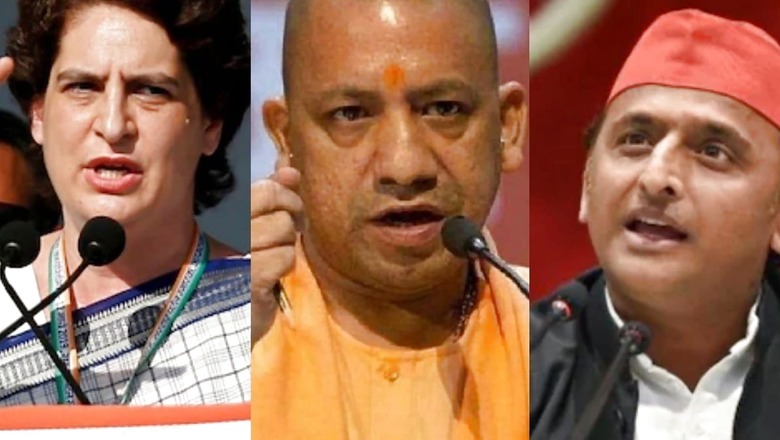
views
All eyes are on the Uttar Pradesh Assembly elections, seen as a template for Lok Sabha 2024. Historically, state polls are an unreliable barometer of the national mood two years down the line. But UP could well throw up answers to intriguing questions about the shape of things to come.
Is Yogi Adityanath the BJP’s succession plan? If so, will Narendra Modi retire at 75? Can Akhilesh Yadav lead a national opposition coalition? Have we seen the last of Mayawati? What are the chances of Priyanka Gandhi Vadra taking over as Congress chief? And is development-plus-‘Hindu nationalism’ still an effective strategy?
Oddly, Home Minister Amit Shah linked the BJP’s prospects in UP 2022 to Lok Sabha 2024, saying, “If you want to make Modi Prime Minister again in 2024, make Yogi Adityanath the Chief Minister again in 2022”.
Presumably, he meant to seek votes for Yogi in Modi’s name, but ended up conveying that Modi’s re-election was contingent on Yogi. The dovetailing of the two names was intriguing, specially as the UP CM is seen as a charismatic figure in his own right.
Modi, as the sole mass leader with a pan-India appeal, will have the option to bow out only if a successor emerges. While Shah has proved to be a capable number two, his ‘branding’ is currently not that of a supreme leader. For many BJP members, it is hard to envisage a post-Modi scenario, but insiders say his personal inclination would be to retire gracefully like a good swayamsewak.
Yogi has pointedly moulded himself in Modi’s image, as a ‘vikas purush’-cum-‘Hindu hriday samrat’. He, too, is a peculiar mix of the progressive and regressive, talking semiconductors and ‘love jihad’ with equal ease. Like Modi, he understands that polarisation as an electoral strategy has its limits.
If the Modi-Yogi combine scripts a convincing win, the UP CM could be a contender for the top job. Although the 2024 polls would be fought under Modi, Yogi—as the king in the North—would certainly have a big say in party affairs, including tickets for his loyalists.
His emergence as a successor will also depend on his standing within the party. Although not an insider, he has the backing of the RSS and BJP hardliners, at least for now. He is regarded as an able administrator and his adept handling of the explosive Lakhimpur Kheri incident won praise.
Significantly, it was Yogi who delivered the political resolution at the BJP National Executive in November 2021. He not only surmounted internal criticism of his leadership in the wake of the COVID-19 pandemic, but settled his differences with deputy CM Keshav Prasad Maurya. He also had his way in the UP cabinet reshuffle and, in the process, silenced rumours of his ouster.
On the flip side, the moderates see him as overly aggressive on Hindutva, and fear that the saffron robes might send the wrong message to the global community. Besides, he is said to be a Thakur-wadi, who cannot command the goodwill of the Brahmins.
Akhilesh Yadav might well pip Yogi to the post, riding on lingering resentment over the pandemic, the farmers’ agitation, rising prices and unemployment. After all, the BJP has a poor track record against regional parties in two-way contests.
The former CM and Samajwadi Party (SP) chief got off to a late start in the campaign, but has since crafted a credible game plan: strategic alliances, candidate selection on the basis of winnability, wooing MBCs (most backward castes) and focusing on reserved seats.
If he pulls it off, the Opposition could rally around him. He already has an understanding with West Bengal chief minister Mamata Banerjee, and both have rejected a leadership role for the Congress. While regional parties in the West (Shiv Sena-NCP) and South (DMK) are still enamoured of the grand old party, Akhilesh himself shines in comparison with Rahul Gandhi.
Priyanka Vadra is another story altogether. Her standout campaign in UP targets a constituency overlooked by other parties: the women vote. Beyond caste, class and community, spaces that are already occupied by other players, she has cannily focused on the core gender identity.
For the first time, there is a positive buzz around the Congress campaign in UP. Priyanka has belied snide ‘silver spoon’ comments with hard work and attracted admiration for her combative spirit. If she can improve the Congress vote share (6.25 per cent) and/or seat share (seven) even by a few percentage points, she will have reversed her party’s inexorable slide.
The Congress rank-and-file, which in any case sees her as a natural-born leader, might then attempt to force a change at the top. Priyanka herself has been hesitant to take the spotlight off her brother and will only accept the mantle if he doesn’t.
As for the Bahujan Samaj Party (BSP), faced with an existential crisis, a good showing in the Assembly elections is critical. Although Mayawati won twice as many seats as the SP in the Lok Sabha, her party suffered tremendous attrition thereafter. Can the BSP survive under a reclusive leader and her nephew? Only the UP result will tell.
The big question is whether the Mandal parties can triumph against religion and nationalism. The next-gen Yadav leaders have learnt from the BJP’s success with OBCs. Accordingly, the SP—like the Rashtriya Janata Dal in Bihar—is attempting to build a social coalition beyond the M-Y (minorities plus Yadavs) axis. If Yogi triumphs, they will have to rework their strategies.
Strategist Prashant Kishor recently observed that “the 2022 UP state election is not a semi-final”. But in terms of scripting political fortunes and strategic course corrections, it will have a bearing on Lok Sabha 2024.
Bhavdeep Kang is a freelance writer and author of Gurus: Stories of India’s Leading Babas and Just Transferred: The Untold Story of Ashok Khemka. The views expressed in this article are those of the author and do not represent the stand of this publication.
Read all the Latest Opinions here




















Comments
0 comment